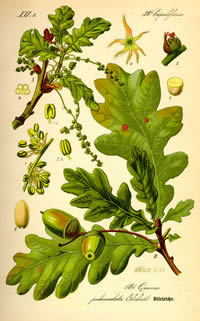Oak Quercus robur

acorns in the sum
- Common Names
- Oak Bark , White Oak
- Botanical Name
- Quercus robur
- Syn. Q. petraea , Quercus alba
- Family
- FAGACEAE
Medicinal Uses & Benefits of Oak Bark
![]() How to Use|
Side Effects |
Plant & Garden|
Folklore
How to Use|
Side Effects |
Plant & Garden|
Folklore
- Medicinal Uses: * Burns
* Cuts & Wounds
* Dental/Oral Care
* Diarrhea
* Kidney
* Sore Throat
- Properties: * Anodyne * Antiscrofulous * Astringent * Depurative * Emmenagogue * Styptic
- Parts Used: Bark
- Constituents: tannin, gallic acid, ellagitannin
How to Use: Oak
The mighty oak tree looms large in both mythology and herbal medicine and has been part of the plant pharmacopoeia for thousands of years. Oak bark is a powerful astringent treatment for throat and mouth infections, bleeding gums, and to cure acute diarrhea. Oak bark is a styptic, one of the herbs used to slow bleeding in cuts and wounds. Oak bark tinctures and extracts have been studied for use in kidney infections and kidney stones. 2 Using oak bark externally as an alcohol tincture or cream helps fight staph infections. Use it in a cold compress to treat burns and cuts. 3
Preparation Methods & Dosage : Oak bark can be brewed into a strong, astringent decoction that can be taken as a tea, or used in baths, douches and skin washes. Use it in a cold compress for burns and cuts, and incorporate oak bark extracts and tinctures into ointments. Oak bark powder is used in tooth and gum powders.
Oak Side Effects: Avoid taking oak bark at the same time as prescription meds.
Plant Description

Flora von Deutschland, Österreich und der Schweiz 1885
There are several hundred species of trees that have the common name oak. The genus Quercus is (from the latin "oak tree") is native to the northern hemisphere, and includes deciduous trees and evergreens, or "live oaks". 1
History and Traditions & Folklore
Of all the trees in prehistoric times the oak Quercus was the most widely venerated of all sacred plants because in the mythological belief of many ancient tribes the oak was the first tree created and man sprang from it. The oak tree was in antiquity sacred to the Hebrews, the Greeks dedicated it to Zeus, to the Romans the oak was the tree of Jupiter; and to the Teutonic tribes, the Tree of Life, sacred to Thor. It was the celestial tree of the Celtic Druids, also the sacred tree of the pagan Dagda, the Good God and Creator of the ancient Irish Gaels. The fruit of the oak, the life giving acorn, main food of the Nordic tribes, became the symbol of fecundity and immortality.4
- Wikipedia
- Mabey, Richard. "The New Age Herbalist",(1988)
- Mountain Rose Herbs
- Ernst and Johanna Lehner. "Folklore and Symbolism of Flowers, Plants and Trees" (2003)











